mspohr
Well-Known Member
Here's a graph on NEM3 that was posted a few days ago:When I looked over NEM 3.0, my impression was (for the most part, anyway) that export rates are market, less non-bypassable charges. Excluding NBC, the import/export hourly differences were probably (maybe ?) explained by demand charges.
I admit, it does seem fair to credit PV exporters with demand savings that accrue from distributed energy but that is way beyond me to talk about in any detail.
You can see from this that export prices are much lower than import prices.
Also, it's interesting that export prices don't rise much during peak demand times but import prices do rise a lot.



